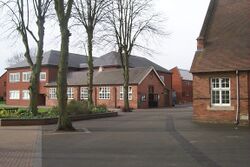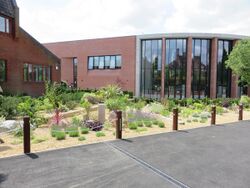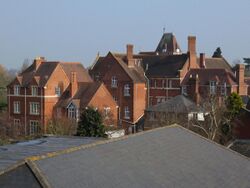Organization:Warwick School
| Warwick School | |
|---|---|
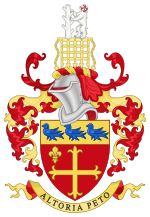 | |
| Location | |
| Lua error in Module:Mapframe at line 384: attempt to perform arithmetic on local 'lat_d' (a nil value). | |
Warwick , Warwickshire , CV34 6PP | |
| Coordinates | [ ⚑ ] : 52°16′45″N 1°34′26″W / 52.279234°N 1.573883°W |
| Information | |
| Type | Public school Private day and boarding school |
| Motto | Altiora Peto (Latin) (I seek higher things) |
| Religious affiliation(s) | Church of England |
| Established | 914 |
| Founder | Æthelflæd of Mercia |
| Department for Education URN | 125781 Tables |
| Chairman of Governors | A. C. Firth |
| Head Master | J. S. Barker, BA (Senior School) A. Hymer, MAEd (Junior School) |
| Deputy Headmaster | S. Chapman, MA, PHD (Senior School) T. Wurr, BA (Junior School) |
| Staff | ca.130 |
| Gender | Boys |
| Age | 7 to 18 |
| Enrolment | 1245 |
| Colours | (Sports) Blue and White (Old Warwickians) Maroon, Black and White |
| Former pupils | Old Warwickians |
| Website | http://www.warwickschool.org/ |
Warwick School is a public school (British independent boarding and day school) in Warwick, England.
Known until about 1900 as King's School, Warwick, it is believed to have been founded by Æthelflæd of Mercia in 914 AD, making it the fifth-oldest surviving school in England, after King's School, Canterbury; King's School, Rochester; St Peter's School, York; and Wells Cathedral School. It may also be the oldest surviving school founded by a woman and the oldest public school in the world to remain open only to boys.[citation needed] Its headmasters have been members of the Headmasters' and Headmistresses' Conference since 1896.
The school is part of the Warwick Independent Schools Foundation, which also owns The King's High School for Girls and Warwick Preparatory School.
History
Early beginnings and the move to St Mary's
The town of Warwick was first recorded in the 9th and 10th century Anglo-Saxon Chronicle in 914 during the rule of Æthelflæd, daughter of Alfred the Great. Warwick School was active in the time of King Edward the Confessor (1042–1066) and probably for at least a century earlier,[1] most likely in the grounds of Warwick Castle. By 1477 lessons were held in the old church of St John the Baptist in the Market Place. In 1545 King Henry VIII re-founded the school as "The King's New Scole of Warwyke" and the new grammar school moved to what is now the Lord Leycester Hospital.[1] Later it moved again to St Peter's Chapel, now part of King's High School. Schoolmasters in the 17th century included the epigrammatist John Owen (1595–1622) and Rev Thomas DuGard (1633–49), later Rector of Barford Church, who recorded the history and daily life of the school in his Latin diary. Around 1697 the school moved to the disused medieval buildings of the Vicars Choral in St Mary's churchyard, and stayed there for the next 200 years.
Victorian era: growth followed by crisis
In the Victorian era, the Rev. Herbert Hill, headmaster from 1842 to 1876, implemented several educational reforms and a modern curriculum was introduced. Three new schools were proposed in the 1870s, and had all begun operations by 1879: The King's Grammar School, on a new site south of the River Avon, with a classical curriculum; The King's Middle School in The Butts, providing a "commercial education" for "less academic" boys; and King's High School, in Landor House, Smith Street. The Junior Department (now the Junior School) opened in 1889. In 1887 "The Limes" (16 lime trees) were planted to mark Queen Victoria's Golden Jubilee.
The years 1896 to 1906 were ones of increasing crisis for the school, however, culminating in its economic collapse and temporary closure, the flight of the headmaster, the sacking of all the staff and the withdrawal of most of the boys. In 1906, the grammar school merged with the King's Middle School.[2]
The World Wars and independence
Under the physicist H. S. Pyne, headmaster from 1906 to 1928, the school rapidly grew in numbers. By the late 1920s, there were almost 400 boys in the school, including 146 boarders, almost double the planned number.
The First World War had a shattering effect on the school. Eighty-eight old Warwickians, including Pyne's son, were killed, as well as two former schoolmasters. Pyne paid for the chapel gallery and west window as a war memorial.
The new headmaster appointed in 1928, G. A. Riding, previously a housemaster at Rugby School, saw himself as a "new broom sweeping clean", after the school had undergone some decline. His time in charge was controversial and was marred by two arson attacks in 1930. In 1933, he was succeeded by Eric Percival Smith, who also did not stay long, leaving in 1936.[3]
Headmaster A. H. B. Bishop served the school from 1936 to 1962. During the Second World War, the number of boys grew, increasing to 450 by 1946. It was difficult to appoint and retain adequate staff, and between 1939 and 1940 the school was forced to share its premises with a school evacuated from Birmingham.[4]
The Butler Education Act was enacted in 1944, and one of its effects was to put an end to the substantial Local Education Authority subsidy to the school. In 1946, the governors were forced to declare that Warwick School would have to become private.[4]
Late 20th Century stability
By 1962, there were 742 pupils and 44 staff in the senior and junior schools combined.[5] Recognition for the school included a visit by Queen Elizabeth the Queen Mother in 1958, as well as earlier visits by Viscount Montgomery of Alamein and Sir Anthony Eden (Prime Minister 1955–1957).
Notable modernisation efforts were undertaken by the headmasters P. W. Martin (1962 to 1977) and Dr P. J. Cheshire (1988 to 2002), who both extensively improved the school's buildings and facilities. All teaching in the original 1879 classrooms finished, and a museum and functions room was opened, named the Portcullis Room. In 1995, the school roll reached 1,000 pupils for the first time.[1]
In the 2000s, Sixth form girls from the King's High School were allowed to participate in certain school activities, and some joint teaching started. The school's rugby team won the Daily Mail Cup in 2007, and the school's concert band and drama students received national recognition.
Two histories of the school have been published: History of Warwick School by A. F. Leach (1906)[6] and Warwick School, A History by G. N. Frykman and E. J. Hadley (2004).[7] Gervald Frykman was the school's first Archivist, and Eric Hadley edited the school's yearly chronicle The Portcullis. A second edition of Frykman and Hadley was published in 2014, to commemorate the assumed 1,100th anniversary of the foundation of the school.
Modern buildings
Although the 1879 buildings are still in use, there have been many additions. All teaching now takes place in specialised departmental areas.
The Junior School, opened in 1889, is next to the main school. Although it closed and re-opened several times in the first half of the twentieth century, it has been fully operational since 1938. In 2006 it catered for over 240 boys from 7 to 11 years of age, the majority of whom were expected to pass into the senior school.[8]
A new Science Centre, designed by Brown Matthews Architects Ltd., opened in June 2007. It houses biology, physics and chemistry laboratories. It was built on the site of the original 1879 sanatorium.
The former main hall of the school, the Guy Nelson Hall, was built, following an appeal, between 1969 and 1970, and was named after Alderman Guy Nelson, a long-serving Chairman of Governors, in office from 1938 to 1963. It had seating for about 600 people, but by 2010 this was much less than the total size of the school, with the result that a new building was planned. The hall was demolished in 2015 and was replaced by a much larger one, Warwick Hall, opened in September 2016 by Sir Michael Attenborough.[5]
The school's theatre, called the Bridge House Theatre,[9] has seating for around 310 people. Intended from the outset to be used both by the school and by local organisations in the town, it was designed by Michael Reardon Associates and was opened on 1 May 2000 by Dame Judi Dench.
In March 2013, the revamped and modernised Sports Pavilion, renamed the Halse Sports Pavilion after former headmaster Edward B. Halse (2002–2013), was opened in a ceremony led by the politician and former track and field athlete Sebastian Coe.[10] On 2 June 2014, as the climax of the Jubilee year, Charles, Prince of Wales, visited the school and unveiled a commemorative plaque.[11]
Entrance
Entrance to Warwick School is competitive, with admissions judged by a combination of internal exams and interview for both the junior and senior schools.[12] Entry to the senior school is permitted at 11+, 13+ and Sixth form (or Upper School). For the Upper School, at age 16, admissions are judged by subject-specific exams and interviews and offers are conditional upon GCSE and IGCSE results.
In 2019–20 there were 969 boys in the senior school (aged 11 to 18), and 250 in the junior school (aged 7 to 11).
Houses
Boys in the senior school are assigned to one of six houses which compete against each other in sports and other activities, such as debating. The six houses are named after people connected with the history of the town of Warwick (Tudor, Guy, Greville, Brooke, Oken, and Leycester). The school's two boarding houses, Way House and School House, are separate from the main house system, with boarders being members of both a boarding house and one of the six main houses.
| House | Namesake | House Colours | |
| Guy | Guy of Warwick | Magenta | |
| Brooke | Earl Brooke | Red | |
| Greville | Earl of Warwick | Green | |
| Leycester | Lord Leycester | Blue | |
| Oken | Thomas Oken | Black and Silver | |
| Tudor | Henry VIII | Gold | |
The Junior School has four houses named after historical figures with no special connection to Warwick (Drake, Scott, Wellington, and Nelson).
Traditions
Visit of the Town Crier
The Town Crier of Warwick traditionally visits the school to announce an added week of holiday for the Michaelmas half term. The ceremony involves a speech, read from a parchment to the whole school in the chapel quad, a mock discussion with the headmaster, and the declaration of the holiday, to cheers from the boys. The Town Crier then takes up a collection for charity from the pupils and staff. This tradition is believed to date back to at least 1912.[13]
The School Arms
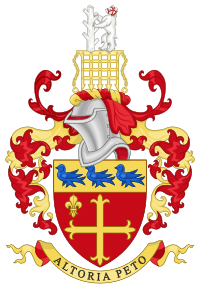
|
|
The Rev. John Pearce Way, headmaster from 1885 to 1896, was the first to attempt to draw up a school coat of arms. He also commissioned the first written history of the school, attempted to change its name from The King's School, Warwick, to Warwick School, and introduced a school song and a school motto. He succeeded with the school motto, Altiora Peto (I seek higher things), introduced in 1893, but neither the name change nor the coat of arms were legally established.
Horace Seymour Pyne, headmaster from 1906 to 1928, also attempted to create a coat of arms – again irregularly, without a grant from the College of Arms – and caused it to be incorporated into the stained glass window of the chapel, where it remains.
George Riding, headmaster from 1928 to 1933, eventually took the appropriate legal steps to obtain a coat of arms, which was granted to Warwick School in 1931. Riding designed the coat of arms, which is blazoned (described heraldically) as follows:
- Arms: Gules, a cross flory in the first quarter a Fleur-de-lys Or, on a chief of the second three martlets Azure.
- Crest: On a wreath Or and Gules, upon a portcullis chained Or a bear erect Argent muzzled Gules supporting a ragged staff also Argent.
- Motto: Altiora Peto (I seek higher things)
The three azure (blue) martlets are heraldic swallows, depicted without feet because of a medieval belief that they could not perch on the ground. Like the large golden cross, they are emblems used by King Edward the Confessor, reputed to be one of the original founders of the school. The gold fleur-de-lys and portcullis are emblems of King Henry VIII, who re-founded the school in 1545, and the Bear and Ragged Staff have been the crest of the family of the Earl of Warwick since at least the 14th century.[15]
Uniform
Regular Uniform
In the 1920s the uniform at Warwick School was simple: clothing was expected to be black, although trousers were also allowed to be grey and neckties dark blue. Boys below a certain height (5'6", or 1.68m) were required to wear the unpopular and uncomfortable Eton collar.[16] In the 1930s the current uniform was introduced: a navy blue blazer, worn with a white shirt (or grey in junior school), black or charcoal trousers (with shorts for Junior School), and a tie. Sixth form dress is a dark grey or navy suit.
Ties and awards
Special ties are awarded to pupils for achievement in different areas, and can be worn in place of their regular school tie:
- Prefect tie: red and silver stripes
- Full colours (for sport, drama and music): silver/white and blue stripes
- Half colours (for sport, drama and music): blue and silver/white stripes (an inversion of "full colours")
Boarders also have a system for recognition of officials in their houses, being:
- Head of boarding house – gold badge and prefect tie
- Boarding prefects – silver badges and prefect tie
Heads of House are promoted from the existing prefect body, with the roles of deputy Head of House and captains of individual sports now being honorary.
School magazines
The Portcullis and The Free Press are the official school magazines, the first having been in print since the late 19th century. Both are contributed to by the boys of the school, with the latter having a tradition of mocking and satirising school policies and teacher. Individual subjects also have their own publications, including The Scientist (Science) and Generation Rising (English).
School Song
The school has had two main songs throughout its history. Currently, the 1906 Latin song Floreat Domus is sung quite regularly - in chapel at the beginning of every term, and at Speech Day, for example. The original English School Song however is reserved now only for Old Warwickian gatherings, not being sung throughout the normal school year.
Floreat Domus
Gaudeamus nos alumni
Quod per infinita saecla
Schola perduravit ipsa.
Gaudeamus nos alumni.
Floreat! Floreat!
Schola Warwicensis
Floret atque floreat
Schola Warwicensis.
Haec domus duret per aevum
Floreant omnes alumni
Floreant semper magistri.
Gaudeamus nos alumni.
Floreat! Floreat!
Schola Warwicensis
Floret atque floreat
Schola Warwicensis.
Head Masters
Notable Old Warwickians
Notable Old Warwickians include:
Politics and public life
- Daniel Byles: Guinness World Record holding ocean rower and polar explorer, Conservative MP for North Warwickshire 2010–2015. Head of House 1985 – 1992
- Harry Greenway: Conservative MP for Ealing until 1997
- Colin Jordan: National Organiser of the British National Party
- Sir Stephen Lovegrove: UK National Security Adviser
- Frederick, Lord Mulley: Secretary of State for Defence, later Secretary of State for Education and Science
- Sir Thomas Puckering : MP and Sheriff of Warwickshire
- Sir Tim Barrow: British diplomat
- Daniel Dalton: Conservative politician and former professional cricketer
- Tony Whittaker: co-founder and first leader of PEOPLE, forerunner of the Green Party
- Joseph Parkes: Political reformer
Religion
- Abiezer Coppe: 17th century "ranting" Baptist preacher
- John Ley: clergyman and religious controversialist
- Henry Teonge: diarist, naval chaplain and Warwickshire parson
- John Richardson: Archbishop of Fredericton
- Samuel Dugard: Anglican Divine
- John Ryland: Baptist minister
Sport
- A G K Brown: Olympic gold medallist 1936, head boy 1933 – 1934
- Jamie Elson: member of the winning UK&I Walker Cup Golf Team defeating the US in 2001
- Christian Horner: Team Principal – Red Bull Racing
- Ben Howard: Rugby Union Player – Worcester Warriors
- Robert Challoner: Australian rugby union player
- Tim Dalton: English Rugby Union International
- John Hacking: cricketer for Warwickshire
- Jack Marshall: cricketer for Warwickshire
- Ward Maule: cricketer and clergyman
- Marko Stanojevic: Italian rugby union player
- Chris Whiteside: cricketer for Middlesex
- Sidney Nelson Crowther: Rugby union international
- Paul Ramage: cricketer and later a head master
- Jamie Shillcock: Worcester Warriors rugby player
- Geoffrey Tedstone: cricketer for Warwickshire and Gloucestershire
- Nick David: Worcester Warriors rugby player
- Tom Dodd: Worcester Warriors rugby player
- Rob Yates: cricketer for Warwickshire
Entertainment
- Sabine Baring-Gould: author of Onward, Christian Soldiers
- Eric Hope: concert pianist
- Denis Matthews: concert pianist
- Rod Thomas: musician, Bright Light Bright Light
- Michael Billington: author, critic & broadcaster
- John Camkin: journalist, TV sports presenter and businessman
- Simon Cheshire: children's writer
- Marc Elliott: actor, EastEnders
- Charles Piff (alias Charles Kay): Actor
- John Masefield: Poet Laureate
- Iain Pears: novelist
- M J Trow: writer
- Henry Baynton: actor
- John McLusky: James Bond illustrator
- Ben Hanlin: magician
- Joshua McGuire: actor
- James TW: singer/songwriter
- Ferdinand Kingsley: actor (son of Sir Ben Kingsley)
- Edward Chattaway: journalist and editor of The Star from 1930 to 1936
- Francis Wilford-Smith: cartoonist, graphic artist, and producer and archivist of blues music
- Mark Evans: TV Presenter
Science
- Robert Thomson Leiper
- Josiah Court: England physician who determined the cause of miners' nystagmus
- Alfred Nicholson Leeds
- Geoff Wilde: designer of the Rolls-Royce RB211
- Cyril Burt: controversial psychologist known for studies on IQ hereditability
Industry
- Geoffrey Healey: co-designer, with his father Donald Healey, of Healey and Austin-Healey cars
- William James: promoter of rail transport
- Denys Shortt: businessman
Military
- Air Commodore Peter J. M. Squires
- Lieutenant-General Peter Strickland
Other
- Sir David Foskett: High Court judge
- John Owen: headmaster c. 1595 – 1622
- Martin Richards: Chief Constable of Sussex Police
- Sir Robert Vyner: Lord Mayor of London
Notable current and former teachers
- John Collett Ryland: Baptist minister
- Alex Burghart: Member of Parliament for Brentwood and Ongar
- Jane Gurnett: actress and current part-time drama teacher
- Geoffrey Tedstone: Former professional cricketer and sports teacher
See also
- List of the oldest schools in the United Kingdom
- List of the oldest schools in the world
References
- ↑ 1.0 1.1 1.2 "The Warwick School Story". https://www.oldwarwickians.org/page/?title=The+Warwick+School+Story&pid=41.
- ↑ "Crisis". https://www.oldwarwickians.org/page/?title=Crisis&pid=35.
- ↑ "Early 20th Century Growth". https://www.oldwarwickians.org/page/?title=Early+20th+Century+Growth&pid=36.
- ↑ 4.0 4.1 "War and Independence". https://www.oldwarwickians.org/page/?title=War+and+Independence&pid=37.
- ↑ 5.0 5.1 "Post-War Stability and Growth". https://www.oldwarwickians.org/page/?title=Post%2DWar+Stability+and+Growth&pid=38.
- ↑ Leach, Arthur Francis (1906). History of Warwick School : with notices of the collegiate church, gilds, and borough of Warwick. Robarts – University of Toronto. London: A. Constable. http://archive.org/details/historyofwarwick00leac.
- ↑ Frykman, G. N. (2004). Warwick School : a history. Hadley, Eric., Warwick School.. Oxford: Gresham Books in partnership with Warwick School. ISBN 0946095469. OCLC 62274749.
- ↑ "A brief history of Warwick Junior School". https://www.oldwarwickians.org/page/?title=A+brief+history+of+Warwick+Junior+School&pid=290.
- ↑ "The Bridge House Theatre in Warwick" (in en-US). https://www.bridgehousetheatre.co.uk/.
- ↑ "Let's keep legacy alive – Lord Coe". The Leamington Spa Courier. 23 March 2013. http://www.leamingtoncourier.co.uk/news/local/let-s-keep-legacy-alive-lord-coe-1-4924465.
- ↑ "HRH The Prince of Wales visits Warwick School". http://www.warwickschool.org/royal-visit.
- ↑ "Senior School Admissions". https://www.warwickschool.org/senior-school-admissions.
- ↑ Hughes, Ian (2017-11-04). "Town Crier visits Warwick School to give announcement in historical style" (in en). https://leamingtonobserver.co.uk/news/town-crier-visits-warwick-school-to-give-announcement-in-historical-style/.
- ↑ "Warwick School". Heraldry of the World. https://www.heraldry-wiki.com/heraldrywiki/index.php?title=Warwick_School. Retrieved 14 February 2023.
- ↑ Frykman, G.N. (2008). "Warwick School Arms and Motto". https://www.oldwarwickians.org/page/?title=Warwick+School+Arms+and+Motto&pid=65.
- ↑ Frykman, G.N. (2018). "Warwick School Uniform in the 1920s". https://www.oldwarwickians.org/page/?title=Warwick+School+Uniform+in+the+1920s&pid=399.
- ↑ "Staff and Governor List". https://www.warwickschool.org/page/?title=Staff+and+Governor+List&pid=42.
Further reading
- Arthur Francis Leach (1906). A History of Warwick School with Notices of the Collegiate Church, Gilds, and Borough of Warwick. Archibald Constable and Company Limited. https://archive.org/details/ahistorywarwick00leacgoog.
- G N Frykman and E J Hadley (2004). Warwick School: A History. Gresham Books of Oxford. ISBN 0-946095-46-9.
- Klaus Boehm and Jenny Lees-Spalding (1 November 2005). "Warwick School". Guide to Independent Schools. Trotman. ISBN 0-85660-984-6. http://www.schoolsguidebook.co.uk/schools/Warwick_School.html.
- W.B. Stephens, ed (1969). "The borough of Warwick — Public education". A History of the County of Warwick: Volume 8: The City of Coventry and Borough of Warwick. pp. 539–543. http://www.british-history.ac.uk/report.asp?compid=16059. — The Victoria County History gives a detailed account of the history of education in Warwick from the time of the 1851 census onwards.
- "Warwick School". BBC News. 19 October 2005. http://news.bbc.co.uk/1/shared/bsp/hi/education/04/school_tables/secondary_schools/html/937_6020.stm.
- "Warwick School". ISI Reports. Independent Schools Inspectorate. http://www.isinspect.org.uk/reports/2002/1277_02.htm.
- Roger Wilmut. "Warwick School in 1961". http://rfwilmut.net/warwick/wschool.html. — Mr Wilmut attended the school from 1953 to 1961. Pictures on the site include the New Buildings and Orlits, which were demolished in 1974 and 1995 respectively.
External links
- Official website
- ISI Inspection Reports
- What's On at the Bridge House Theatre
 |





